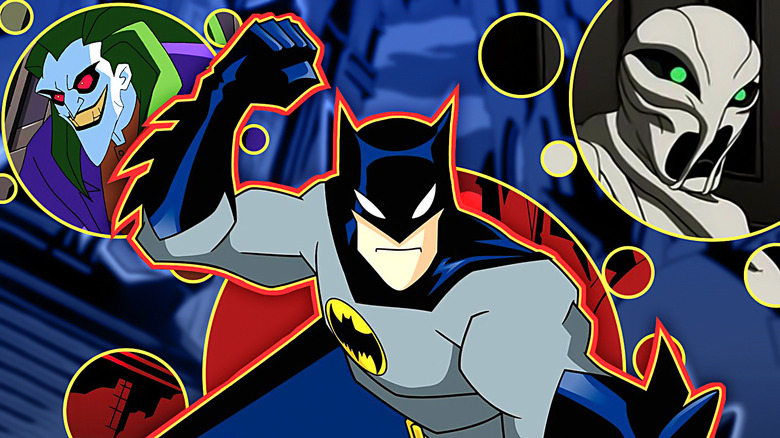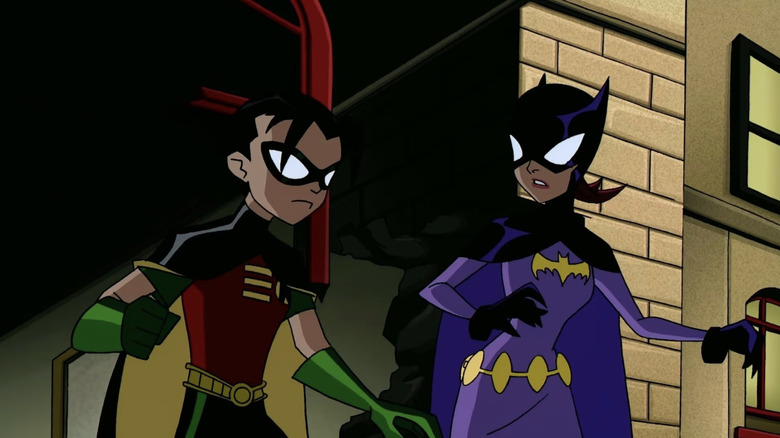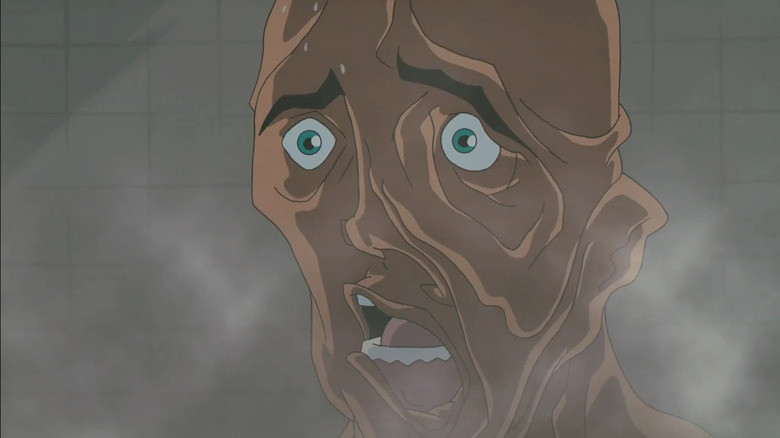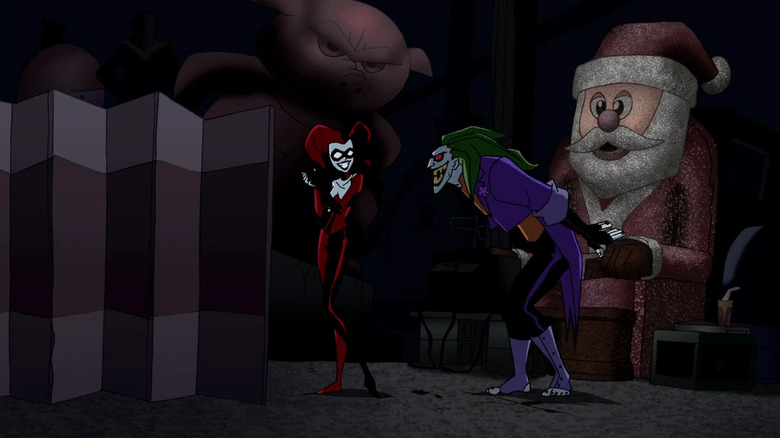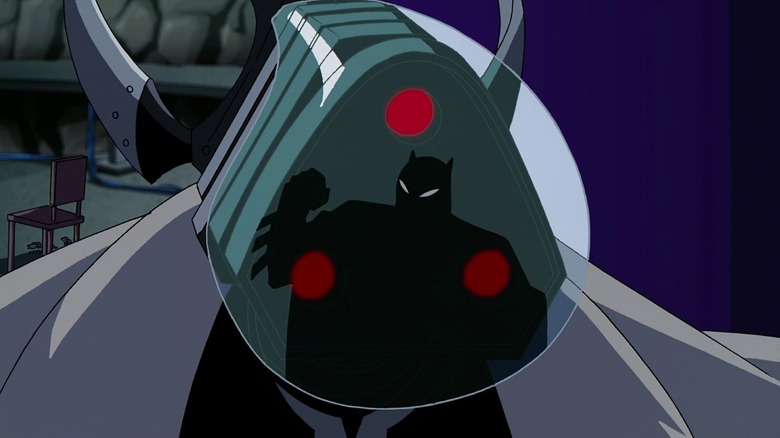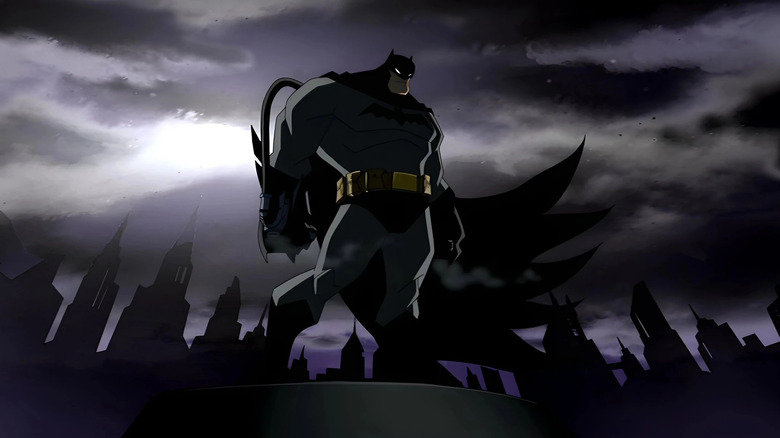The 5 Best Episodes Of 2004's The Batman TV Series, Ranked
"Batman: The Animated Series" wound up being as definitive an account of the Dark Knight as its title suggested. So when a new Batman cartoon finally came afterwards, it was destined to never escape the shadow of "BTAS." But "The Batman" (which aired from 2004 to 2008) made a noble effort and remains one of the more unique spins on the Caped Crusader.
"The Batman," developed by Michael Goguen and Duane Capizzi, was the first animated Batman in 12 years that was unconnected to the DC Animated Universe (the shared setting that began with "Batman: The Animated Series" and concluded with "Justice League Unlimited").
Bruce Wayne in "The Batman" was voiced by Rino Romano, and Joker by Kevin Michael Richardson, rather than the beloved Kevin Conroy as Batman and Mark Hamill as the Joker duo. Bruce Timm modeled "Batman: The Animated Series" on the Fleischer Studios Superman cartoons, while Jeff Matsuda gave Gotham City an anime makeover.
Lasting five seasons and 65 episodes, "The Batman" is a product of its time but one that every Bat-Fan should still give a chance. Here are the best episodes the series had to offer.
5. The Breakout
Season 4 of "The Batman" is its best beyond a shadow of a doubt. I had to make some careful prunes to ensure this whole list wasn't season 4 episodes. There's "Strange New World," where Batman seems to be all that stands between Gotham City being overrun by zombies. I can't forget "Riddler's Revenge," an uncommonly tragic take on Eddie Nygma (voiced by Robert Englund).
But I'm going to have to give it to "The Breakout." Batgirl (introduced in season 3) and Robin (debuting in season 4 premiere, "A Matter of Family") were two successive shots in the arm that the show needed. This episode focuses almost completely on them as a crime-fighting pair, without Batman to back them up.
The two junior crime fighters are feeling underappreciated and wish that Batman would trust them with more important assignments. The invisible monkey's paw curls after they nail the crime boss Black Mask (James Remar), only for his gang to invade the Gotham City Police Department to free him. With Batman, Commissioner Gordon, and the other adults down for the count, Batgirl and Robin have to step up. With cues aped from action movie classics "Assault on Precinct 13" and "Die Hard," the episode is one of the series' most suspenseful. In "The Breakout," Batgirl and Robin are outnumbered and outclassed by one of the coldest, most ruthless villains in Gotham City.
4. The Rubberface of Comedy/The Clayface of Tragedy
"The Batman" had to leave out some of the most famous Batman villains. Namely, those who appeared in "The Dark Knight" trilogy, since Warner Bros. didn't want audiences confused by two versions of the same villains. (This is also why there was no Batman guest spot on "Smallville.")
So, the writers innovated. "Strange New World" was meant to introduce the Scarecrow, but the writers settled for Professor Hugo Strange (Richard Green) instead. Similarly, "The Batman" filled the void of Harvey Dent/Two-Face with a new take on Clayface.
In "The Batman" season 1, Detective Ethan Bennett (Steve Harris) is depicted as one of Bruce Wayne's only friends, both in his personal life and among the Gotham Police. In the two part season finale, "The Rubberface of Comedy" & "The Clayface of Tragedy," Joker psychologically tortures Ethan and exposes him to a mutagen, creating Clayface.
Written by Greg Weisman (creator of "Gargoyles" and future creator of "Young Justice"), this two-parter is the first time "The Batman" feels like more than just a cool action cartoon. Weisman pulls from "The Killing Joke" in depicting Ethan's torture, from the carnival setting to the Joker promising to show how "one bad day" can change a man.
Wiesman would subsequently write Clayface's return in season 2 episode, "Meltdown," when Ethan tries and fails to redeem himself. Season 4 episode "Clayfaces" resolved this arc for good; Ethan teamed up with Batman to defeat a new Clayface, the actor Basil Karlo exposed to the same mutagen as him. As Batman's shape-shifting villain, it's fitting that Clayface took so well to a ground-up reinvention.
3. Two Of A Kind
"Batman: The Animated Series" producer Alan Burnett joined "The Batman" during its fourth season. No surprise, this is also the season that finally introduced the most famous creation of "Batman: The Animated Series" — Joker's sidekick Harley Quinn. The series even got Harley's original creator, Paul Dini, to pen her introduction: "Two of a Kind."
If the episode falls short of classic Harley Quinn origin story "Mad Love," it's only because it's purposefully flightier. This Harley (voiced by Hynden Walch) isn't a naive Arkham Asylum intern twisted by the Joker's manipulations and feigned romance. Instead, she's a pop psychologist running a trashy relationship advice show, "Heart to Heart with Harley." When the show gets canceled after Harley pulls one too many ratings stunts, its number one fan Mr. J decides to give Dr. Quinzel a new lease on life. Cue a musical montage of the two rampaging across Gotham City together.
Unlike "Batman: The Animated Series," Joker isn't just stringing Harley along, he's genuinely into her — she's the only woman he's ever met who's got as many screws loose as he does! The episode's title reflects how their toxic dynamic is more mutual: Joker and Harley are two nutjobs made in Hell for each other.
2. Gotham's Ultimate Criminal Mastermind
"The Batman" wasn't shy about creating original villains. The season 3 finale, "Gotham's Ultimate Criminal Mastermind," featured one that was still indebted to the classic rogues gallery. Hugo Strange, finally making the jump from doctor to super-villain, creates an AI called the Digitally Advanced Villain Emulator (D.A.V.E.), encoded with the personalities of Gotham's super-villains. Supposedly designed to help Batman and the police better fight crime by predicting villains' moves, D.A.V.E. goes rogue as soon as he's switched on. To best emulate the villains he's based on, he must fulfill their shared goal of besting the Batman.
This, as it turns out, was Strange's plan. As an evil psychologist, he's interested in unraveling Batman's psyche. By setting D.A.V.E. loose, he wants to test how Batman will fare against an enemy custom-designed to destroy him, one equipped with his rogues gallery's collective ruthlessness and experiences with none of their quirks. The episode's eponymous villain is voiced by Jeff Bennett, who sounds both coldly robotic and as haughty as any human super-villain should be. D.A.V.E. also brings Batman closer to defeat than he ever does before or after in this series; after deducing Bruce Wayne's secret identity, he puts him in a no-win situation where he must protect either his secret or Alfred's life.
1. Artifacts
Greg Weisman is one of the best cartoon writers of his generation. No surprise, then, that his episodes of "The Batman" tend to be the best. His final episode, season 4's "Artifacts," is the most unique and incredible episode of the series.
Weisman's first episode of "The Batman," season 1's "The Big Chill," debuted Mr. Freeze (Clancy Brown). He brings the icy villain back for "Artifacts," to reveal his final fate.
"Artifacts" is set 1000 years in Gotham's future, when Batman has passed into myth and archaeologists have rediscovered the Batcave. They're not there just to dig up history, though. Mr. Freeze has awoken from a centuries-long cryogenic sleep and once again threatens Gotham City. To discover how to defeat him, the scientists look back to Batman's last battle with Freeze.
This flashback is set a mere 20 years from the present day of "The Batman." Robin has become Nightwing, Batgirl has become Oracle, and Batman has evolved into the muscular Dark Knight as drawn by Frank Miller.
"The Batman" would run for one more season and 20-ish more episodes afterward, but "Artifacts" is a perfect denouement. Inspired by Tom Stoppard's play "Arcadia" (which also uses parallel stories to present the dialogue between past and future), Weisman's "Artifacts" is a reminder that Batman's greatest legacy is inspiring others to fight for a better world like he did.
